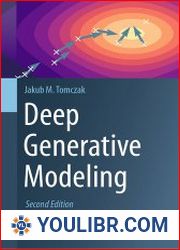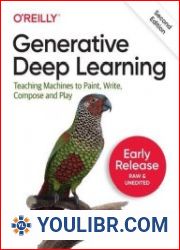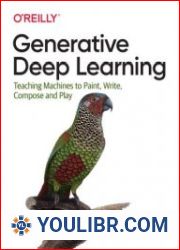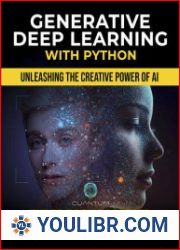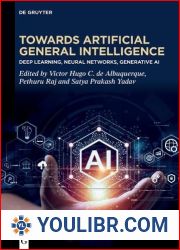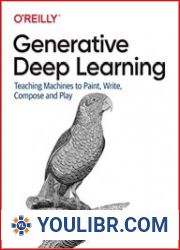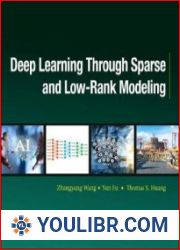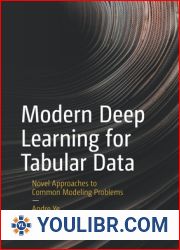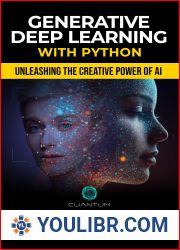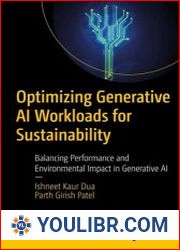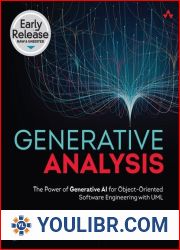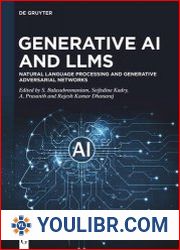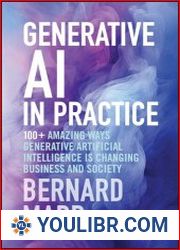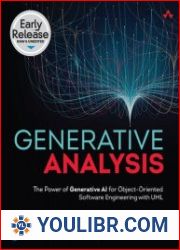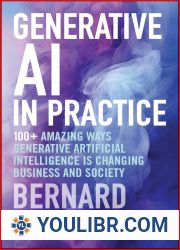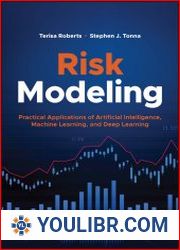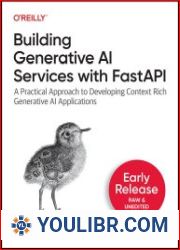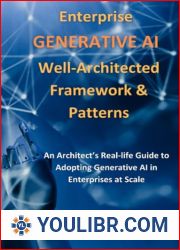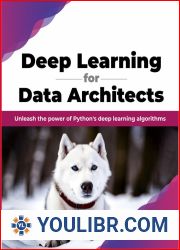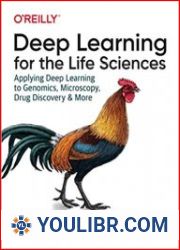
BOOKS - Deep Generative Modeling, 2nd Edition

Deep Generative Modeling, 2nd Edition
Author: Jakub M. Tomczak
Year: 2024
Format: PDF | EPUB
File size: 50.2 MB
Language: ENG
Year: 2024
Format: PDF | EPUB
File size: 50.2 MB
Language: ENG
This first comprehensive book on models behind Generative AI has been thoroughly revised to cover all major classes of deep generative models: mixture models, Probabilistic Circuits, Autoregressive Models, Flow-based Models, Latent Variable Models, GANs, Hybrid Models, Score-based Generative Models, Energy-based Models, and Large Language Models. In addition, Generative AI Systems are discussed, demonstrating how deep generative models can be used for neural compression, among others. Deep Generative Modeling is designed to appeal to curious students, engineers, and researchers with a modest mathematical background in undergraduate calculus, linear algebra, probability theory, and the basics of Machine Learning, Deep Learning, and programming in Python and PyTorch (or other Deep Learning libraries). It should find interest among students and researchers from a variety of backgrounds, including computer science, engineering, Data Science, physics, and bioinformatics who wish to get familiar with deep generative modeling. In order to engage with a reader, the book introduces fundamental concepts with specific examples and code snippets. The full code accompanying the book is available on the author's GitHub site.
Book Description: Deep Generative Modeling 2nd Edition As we continue to advance in the technological age, it is essential to understand the process of technology evolution and its impact on humanity. The second edition of "Deep Generative Modeling" provides a comprehensive overview of the latest developments in generative AI, highlighting the need for a personal paradigm that perceives the technological process of developing modern knowledge as the basis for human survival and unity in a warring state. This book offers a detailed description of the plot, focusing on the evolution of deep generative models, including mixture models probabilistic circuits autoregressive models flow-based models latent variable models GANs hybrid models score-based generative models energy-based models and large language models. These models have revolutionized the field of artificial intelligence, enabling the creation of sophisticated algorithms that can generate complex data sets, such as images and text, with unprecedented accuracy and realism. The book begins by introducing fundamental concepts and providing specific examples and code snippets to facilitate understanding. It covers various classes of deep generative models, including mixture models probabilistic circuits autoregressive models flow-based models latent variable models GANs hybrid models score-based generative models energy-based models and large language models. Each chapter delves into the mathematical background required for undergraduate calculus linear algebra probability theory and machine learning, making it accessible to students and researchers from diverse backgrounds, including computer science engineering data science physics and bioinformatics. The author's GitHub site provides full code accompanying the book, allowing readers to engage with the subject matter more effectively. Глубокое генеративное моделирование 2-е издание По мере того, как мы продолжаем продвигаться в технологической эре, важно понимать процесс эволюции технологий и его влияние на человечество. Во втором издании «Deep Generative Modeling» представлен всесторонний обзор последних разработок в области генеративного ИИ, подчёркивающий необходимость личностной парадигмы, воспринимающей технологический процесс развития современных знаний как основу выживания и единства человека в воюющем государстве. Эта книга предлагает подробное описание сюжета, фокусируясь на эволюции глубоких генеративных моделей, включая модели смесей, вероятностные схемы, авторегрессионные модели, модели на основе потока, модели на основе латентных переменных, гибридные модели GAN, основанные на оценках, генерирующие модели на основе энергии и большие языковые модели. Эти модели произвели революцию в области искусственного интеллекта, позволив создать сложные алгоритмы, которые могут генерировать сложные наборы данных, такие как изображения и текст, с беспрецедентной точностью и реализмом. Книга начинается с введения фундаментальных понятий и предоставления конкретных примеров и фрагментов кода для облегчения понимания. Он охватывает различные классы глубоких генеративных моделей, включая модели смешения, вероятностные схемы, авторегрессионные модели, модели, основанные на потоках, модели, основанные на латентных переменных, гибридные модели GAN, основанные на оценках, генеративные модели, основанные на энергии, и модели на больших языках. Каждая глава углубляется в математическую основу, необходимую для теории вероятностей линейной алгебры и машинного обучения, что делает ее доступной для студентов и исследователей из разных слоев общества, включая информатику, инженерию, физику и биоинформатику. Авторский сайт GitHub предоставляет полный код, сопровождающий книгу, что позволяет читателям более эффективно взаимодействовать с темой. pdf 파일 다운로드 להוריד קובץ PDF download pdf file PDF-Datei herunterladen pdf dosyasını indir Scarica il file pdf download pdf file 下载 pdf 文件 PDFファイルをダウンロード télécharger le fichier pdf скачать файл PDF descarregar ficheiro pdf pobierz plik pdf descargar archivo pdf تنزيل ملف pdf
Este primeiro livro abrangente sobre os modelos subjacentes da IA genérica foi cuidadosamente redefinido para abranger todas as classes básicas de modelos genéricos profundos: modelos de misturas, esquemas prováveis, modelos de regressão automática, modelos baseados em fluxo, modelos de variáveis ocultas, GAN, modelos híbridos, modelos genéricos baseados em pontos, modelos baseados em energia e grandes modelos linguísticos. Além disso, são discutidos sistemas genéricos de IA que demonstram quão profundos os modelos genéricos podem ser usados para compressão neuronal, entre outros. A modelagem genérica profunda é projetada para estudantes, engenheiros e pesquisadores curiosos, com formação matemática modesta em contagem de bacharelado, álgebra linear, teoria de probabilidade e fundamentos de aprendizado de máquina, aprendizagem profunda e programação em Python e PyTorch (ou outras bibliotecas de aprendizagem profunda). Ele deve encontrar interesse entre estudantes e pesquisadores de várias áreas, incluindo informática, engenharia, ciência de dados, física e bioinformática, que desejam conhecer a modelagem genérica profunda. Para interagir com o leitor, o livro introduz conceitos fundamentais com exemplos específicos e pedaços de código. O código completo que acompanha o livro está disponível no site do autor no GitHub.
This first comprehensive book on models behind Generative AI has been thoroughly revised to cover all major classes of deep generative models: mixture models, Probabilistic Circuits, Autoregressive Models, Flow-based Models, Latent Variable Models, GANs, Hybrid Models, Score-based Generative Models, Energy-based Models, and Large Language Models. In addition, Generative AI Systems are discussed, demonstrating how deep generative models can be used for neural compression, among others. Deep Generative Modeling is designed to appeal to curious students, engineers, and researchers with a modest mathematical background in undergraduate calculus, linear algebra, probability theory, and the basics of Machine Learning, Deep Learning, and programming in Python and PyTorch (or other Deep Learning libraries). It should find interest among students and researchers from a variety of backgrounds, including computer science, engineering, Data Science, physics, and bioinformatics who wish to get familiar with deep generative modeling. In order to engage with a reader, the book introduces fundamental concepts with specific examples and code snippets. The full code accompanying the book is available on the author's GitHub site.
Questo primo libro completo sui modelli alla base dell'IA generale è stato attentamente rivisitato per coprire tutte le classi principali di modelli generali profondi: modelli di miscele, schemi probabilistici, modelli di regressione automatica, modelli basati sul flusso, modelli di variabili nascoste, GAN, modelli ibridi, modelli generali basati su energia, modelli linguistici di grandi dimensioni. Inoltre, si discute di sistemi generali di IA che dimostrano quanto i modelli generali profondi possano essere utilizzati per la compressione neurale, tra gli altri. La modellazione generale profonda è destinata a curiosi studenti, ingegneri e ricercatori con una modesta formazione matematica nel campo del calcolo di laurea, algebra lineare, teoria delle probabilità e basi di apprendimento automatico, formazione profonda e programmazione su Python e PyTorch (o altre biblioteche di formazione profonda). Dovrebbe trovare interesse tra studenti e ricercatori di diversi settori, tra cui l'informatica, l'ingegneria, la scienza dei dati, la fisica e la bioinformatica, che vogliono conoscere una modellazione genetica profonda. Per interagire con il lettore, il libro introduce concetti fondamentali con esempi e frammenti di codice specifici. Il codice completo che accompagna il libro è disponibile sul sito web dell'autore.
Эта первая всеобъемлющая книга о моделях, лежащих в основе генеративного ИИ, была тщательно переработана, чтобы охватить все основные классы смешанных моделей глубоких генеративных моделей, вероятностных схем, авторегрессионных моделей, моделей на основе потока, моделей скрытых переменных, GAN, гибридных моделей, генеративных моделей на основе баллов, моделей на основе энергии и больших Языковые модели. Кроме того, обсуждаются генеративные системы ИИ, демонстрирующие, насколько глубокие генеративные модели могут быть использованы для нейронного сжатия, среди прочих. Глубокое генеративное моделирование предназначено для любопытных студентов, инженеров и исследователей со скромным математическим образованием в области исчисления бакалавриата, линейной алгебры, теории вероятностей и основ машинного обучения, глубокого обучения и программирования на Python и PyTorch (или других библиотеках глубокого обучения). Он должен найти интерес среди студентов и исследователей из разных областей, включая информатику, инженерию, науку о данных, физику и биоинформатику, которые хотят познакомиться с глубоким генеративным моделированием. Для того, чтобы взаимодействовать с читателем, книга вводит фундаментальные понятия с конкретными примерами и фрагментами кода. Полный код, сопровождающий книгу, доступен на сайте авторов GitHub.
Ce premier livre complet sur les modèles sous-jacents à l'IA générative a été soigneusement remanié pour couvrir toutes les grandes classes de modèles génériques profonds : modèles de mélange, schémas probabilistes, modèles auto-régressions, modèles à flux, modèles à variables cachées, GAN, modèles hybrides, modèles génériques à base de points, modèles à base d'énergie et modèles à grande langue. En outre, les systèmes génériques de l'IA sont discutés, montrant à quel point les modèles génériques profonds peuvent être utilisés pour la compression neuronale, entre autres. La modélisation génératrice profonde est destinée aux étudiants, ingénieurs et chercheurs curieux ayant une éducation mathématique modeste dans le calcul du baccalauréat, l'algèbre linéaire, la théorie des probabilités et les bases de l'apprentissage automatique, l'apprentissage profond et la programmation sur Python et PyTorch (ou d'autres bibliothèques d'apprentissage profond). Il doit trouver un intérêt parmi les étudiants et les chercheurs de différents domaines, y compris l'informatique, l'ingénierie, les sciences des données, la physique et la bioinformatique, qui veulent se familiariser avec la modélisation générative profonde. Afin d'interagir avec le lecteur, le livre introduit des concepts fondamentaux avec des exemples spécifiques et des fragments de code. Le code complet qui accompagne le livre est disponible sur le site de l'auteur sur GitHub.
Este primer libro completo sobre modelos subyacentes a la IA generativa ha sido cuidadosamente rediseñado para abarcar todas las clases principales de modelos generativos profundos: modelos de mezcla, esquemas probabilísticos, modelos de autorregresión, modelos basados en flujo, modelos de variables ocultas, GAN, modelos híbridos, modelos generativos basados en puntos, modelos basados en energía y Grandes modelos lingüísticos. Además, se discuten sistemas generativos de IA que demuestran cuán profundos modelos generativos pueden ser utilizados para la compresión neuronal, entre otros. El modelado generativo profundo está dirigido a estudiantes curiosos, ingenieros e investigadores con una modesta educación matemática en cálculo de bachillerato, álgebra lineal, teoría de probabilidades y fundamentos del aprendizaje automático, aprendizaje profundo y programación en Python y PyTorch (u otras bibliotecas de aprendizaje profundo). Debe encontrar interés entre estudiantes e investigadores de diferentes campos, incluyendo informática, ingeniería, ciencia de datos, física y bioinformática, que quieran familiarizarse con el modelado generativo profundo. Para interactuar con el lector, el libro introduce conceptos fundamentales con ejemplos específicos y fragmentos de código. El código completo que acompaña al libro está disponible en el sitio web del autor en GitHub.
Dieses erste umfassende Buch über die Modelle, die der generativen KI zugrunde liegen, wurde gründlich überarbeitet, um alle wichtigen Klassen tiefer generativer Modelle abzudecken: Mischmodelle, Wahrscheinlichkeitsschemata, autoregressive Modelle, flussbasierte Modelle, Modelle mit versteckten Variablen, GANs, Hybridmodelle, punktbasierte generative Modelle, energiebasierte Modelle und große Sprachmodelle. Darüber hinaus werden generative KI-Systeme diskutiert, die zeigen, wie tief generative Modelle unter anderem für die neuronale Kompression genutzt werden können. Deep Generative Modeling richtet sich an neugierige Studenten, Ingenieure und Forscher mit einem bescheidenen mathematischen Hintergrund in den Bereichen Bachelor-Kalkül, lineare Algebra, Wahrscheinlichkeitstheorie und Grundlagen des maschinellen Lernens, Deep Learning und Programmierung in Python und PyTorch (oder anderen Deep-Learning-Bibliotheken). Es sollte Interesse bei Studenten und Forschern aus verschiedenen Bereichen finden, darunter Informatik, Ingenieurwesen, Datenwissenschaft, Physik und Bioinformatik, die tiefe generative Modellierung kennenlernen möchten. Um mit dem Leser zu interagieren, führt das Buch grundlegende Konzepte mit spezifischen Beispielen und Code-Fragmenten ein. Der vollständige Code, der das Buch begleitet, ist auf der Website des Autors auf GitHub verfügbar.
Este primeiro livro abrangente sobre os modelos subjacentes da IA genérica foi cuidadosamente redefinido para abranger todas as classes básicas de modelos genéricos profundos: modelos de misturas, esquemas prováveis, modelos de regressão automática, modelos baseados em fluxo, modelos de variáveis ocultas, GAN, modelos híbridos, modelos genéricos baseados em pontos, modelos baseados em energia e grandes modelos linguísticos. Além disso, são discutidos sistemas genéricos de IA que demonstram quão profundos os modelos genéricos podem ser usados para compressão neuronal, entre outros. A modelagem genérica profunda é projetada para estudantes, engenheiros e pesquisadores curiosos, com formação matemática modesta em contagem de bacharelado, álgebra linear, teoria de probabilidade e fundamentos de aprendizado de máquina, aprendizagem profunda e programação em Python e PyTorch (ou outras bibliotecas de aprendizagem profunda). Ele deve encontrar interesse entre estudantes e pesquisadores de várias áreas, incluindo informática, engenharia, ciência de dados, física e bioinformática, que desejam conhecer a modelagem genérica profunda. Para interagir com o leitor, o livro introduz conceitos fundamentais com exemplos específicos e pedaços de código. O código completo que acompanha o livro está disponível no site do autor no GitHub.
This first comprehensive book on models behind Generative AI has been thoroughly revised to cover all major classes of deep generative models: mixture models, Probabilistic Circuits, Autoregressive Models, Flow-based Models, Latent Variable Models, GANs, Hybrid Models, Score-based Generative Models, Energy-based Models, and Large Language Models. In addition, Generative AI Systems are discussed, demonstrating how deep generative models can be used for neural compression, among others. Deep Generative Modeling is designed to appeal to curious students, engineers, and researchers with a modest mathematical background in undergraduate calculus, linear algebra, probability theory, and the basics of Machine Learning, Deep Learning, and programming in Python and PyTorch (or other Deep Learning libraries). It should find interest among students and researchers from a variety of backgrounds, including computer science, engineering, Data Science, physics, and bioinformatics who wish to get familiar with deep generative modeling. In order to engage with a reader, the book introduces fundamental concepts with specific examples and code snippets. The full code accompanying the book is available on the author's GitHub site.
Questo primo libro completo sui modelli alla base dell'IA generale è stato attentamente rivisitato per coprire tutte le classi principali di modelli generali profondi: modelli di miscele, schemi probabilistici, modelli di regressione automatica, modelli basati sul flusso, modelli di variabili nascoste, GAN, modelli ibridi, modelli generali basati su energia, modelli linguistici di grandi dimensioni. Inoltre, si discute di sistemi generali di IA che dimostrano quanto i modelli generali profondi possano essere utilizzati per la compressione neurale, tra gli altri. La modellazione generale profonda è destinata a curiosi studenti, ingegneri e ricercatori con una modesta formazione matematica nel campo del calcolo di laurea, algebra lineare, teoria delle probabilità e basi di apprendimento automatico, formazione profonda e programmazione su Python e PyTorch (o altre biblioteche di formazione profonda). Dovrebbe trovare interesse tra studenti e ricercatori di diversi settori, tra cui l'informatica, l'ingegneria, la scienza dei dati, la fisica e la bioinformatica, che vogliono conoscere una modellazione genetica profonda. Per interagire con il lettore, il libro introduce concetti fondamentali con esempi e frammenti di codice specifici. Il codice completo che accompagna il libro è disponibile sul sito web dell'autore.
Эта первая всеобъемлющая книга о моделях, лежащих в основе генеративного ИИ, была тщательно переработана, чтобы охватить все основные классы смешанных моделей глубоких генеративных моделей, вероятностных схем, авторегрессионных моделей, моделей на основе потока, моделей скрытых переменных, GAN, гибридных моделей, генеративных моделей на основе баллов, моделей на основе энергии и больших Языковые модели. Кроме того, обсуждаются генеративные системы ИИ, демонстрирующие, насколько глубокие генеративные модели могут быть использованы для нейронного сжатия, среди прочих. Глубокое генеративное моделирование предназначено для любопытных студентов, инженеров и исследователей со скромным математическим образованием в области исчисления бакалавриата, линейной алгебры, теории вероятностей и основ машинного обучения, глубокого обучения и программирования на Python и PyTorch (или других библиотеках глубокого обучения). Он должен найти интерес среди студентов и исследователей из разных областей, включая информатику, инженерию, науку о данных, физику и биоинформатику, которые хотят познакомиться с глубоким генеративным моделированием. Для того, чтобы взаимодействовать с читателем, книга вводит фундаментальные понятия с конкретными примерами и фрагментами кода. Полный код, сопровождающий книгу, доступен на сайте авторов GitHub.
Ce premier livre complet sur les modèles sous-jacents à l'IA générative a été soigneusement remanié pour couvrir toutes les grandes classes de modèles génériques profonds : modèles de mélange, schémas probabilistes, modèles auto-régressions, modèles à flux, modèles à variables cachées, GAN, modèles hybrides, modèles génériques à base de points, modèles à base d'énergie et modèles à grande langue. En outre, les systèmes génériques de l'IA sont discutés, montrant à quel point les modèles génériques profonds peuvent être utilisés pour la compression neuronale, entre autres. La modélisation génératrice profonde est destinée aux étudiants, ingénieurs et chercheurs curieux ayant une éducation mathématique modeste dans le calcul du baccalauréat, l'algèbre linéaire, la théorie des probabilités et les bases de l'apprentissage automatique, l'apprentissage profond et la programmation sur Python et PyTorch (ou d'autres bibliothèques d'apprentissage profond). Il doit trouver un intérêt parmi les étudiants et les chercheurs de différents domaines, y compris l'informatique, l'ingénierie, les sciences des données, la physique et la bioinformatique, qui veulent se familiariser avec la modélisation générative profonde. Afin d'interagir avec le lecteur, le livre introduit des concepts fondamentaux avec des exemples spécifiques et des fragments de code. Le code complet qui accompagne le livre est disponible sur le site de l'auteur sur GitHub.
Este primer libro completo sobre modelos subyacentes a la IA generativa ha sido cuidadosamente rediseñado para abarcar todas las clases principales de modelos generativos profundos: modelos de mezcla, esquemas probabilísticos, modelos de autorregresión, modelos basados en flujo, modelos de variables ocultas, GAN, modelos híbridos, modelos generativos basados en puntos, modelos basados en energía y Grandes modelos lingüísticos. Además, se discuten sistemas generativos de IA que demuestran cuán profundos modelos generativos pueden ser utilizados para la compresión neuronal, entre otros. El modelado generativo profundo está dirigido a estudiantes curiosos, ingenieros e investigadores con una modesta educación matemática en cálculo de bachillerato, álgebra lineal, teoría de probabilidades y fundamentos del aprendizaje automático, aprendizaje profundo y programación en Python y PyTorch (u otras bibliotecas de aprendizaje profundo). Debe encontrar interés entre estudiantes e investigadores de diferentes campos, incluyendo informática, ingeniería, ciencia de datos, física y bioinformática, que quieran familiarizarse con el modelado generativo profundo. Para interactuar con el lector, el libro introduce conceptos fundamentales con ejemplos específicos y fragmentos de código. El código completo que acompaña al libro está disponible en el sitio web del autor en GitHub.
Dieses erste umfassende Buch über die Modelle, die der generativen KI zugrunde liegen, wurde gründlich überarbeitet, um alle wichtigen Klassen tiefer generativer Modelle abzudecken: Mischmodelle, Wahrscheinlichkeitsschemata, autoregressive Modelle, flussbasierte Modelle, Modelle mit versteckten Variablen, GANs, Hybridmodelle, punktbasierte generative Modelle, energiebasierte Modelle und große Sprachmodelle. Darüber hinaus werden generative KI-Systeme diskutiert, die zeigen, wie tief generative Modelle unter anderem für die neuronale Kompression genutzt werden können. Deep Generative Modeling richtet sich an neugierige Studenten, Ingenieure und Forscher mit einem bescheidenen mathematischen Hintergrund in den Bereichen Bachelor-Kalkül, lineare Algebra, Wahrscheinlichkeitstheorie und Grundlagen des maschinellen Lernens, Deep Learning und Programmierung in Python und PyTorch (oder anderen Deep-Learning-Bibliotheken). Es sollte Interesse bei Studenten und Forschern aus verschiedenen Bereichen finden, darunter Informatik, Ingenieurwesen, Datenwissenschaft, Physik und Bioinformatik, die tiefe generative Modellierung kennenlernen möchten. Um mit dem Leser zu interagieren, führt das Buch grundlegende Konzepte mit spezifischen Beispielen und Code-Fragmenten ein. Der vollständige Code, der das Buch begleitet, ist auf der Website des Autors auf GitHub verfügbar.







